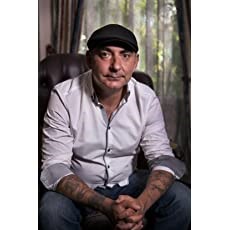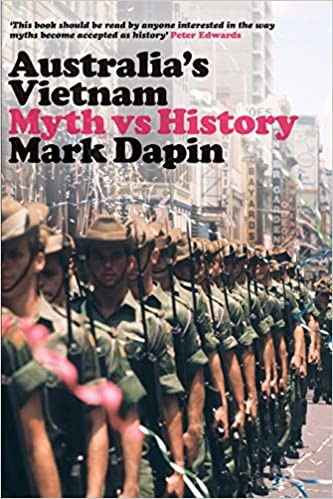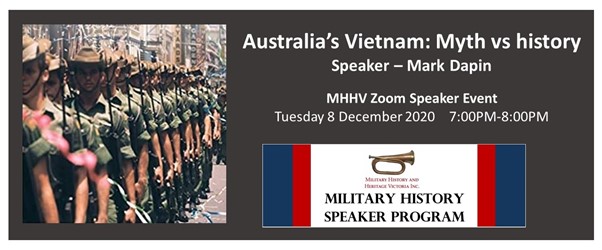In opening, Dr Dapin quipped, to an audience of 30, that his father fought the Korean War from the Sherwood Forest and then from Germany while doing UK national service during the 1950s. He speculated that his initial interest in things military arose from not understanding his father’s experience before he died, and that he was making up for it by researching young Australian soldiers’ experiences.
While writing his previous book, Nasho’s War, about what it was like for young men to be plonked into the Vietnam War he realised that groups of veterans ‘remembered’ their experiences differently when they were interviewed individually. When he spoke to groups of veterans, such as the Vietnam Vets Motorcycle Club in Queensland, he heard consistent stories about their treatment and experiences. He heard that they went to fight a war they didn’t understand, were spat on or had blood thrown at them when they returned to Australia, that many veterans were mentally ill, that there were no welcome home parades until the late 1980s and returned soldiers were met by angry protesters at the airport while planes delivered them home at night to avoid protests. In addition, diggers committed atrocities during the war.
Later, he found that the stories veterans told when they were interviewed separately were different. What he initially believed (and regurgitated) was that many of the ‘facts’ gained from groups turned out to be myths.
Not many veterans he interviewed were mentally ill. On returning home they were not subject to an epidemic of spitting or blood throwing, few had any first-hand experience of angry protesters anywhere let alone at an airport. They had scant knowledge of atrocities committed by Australians.
Dr Dapin went searching for verifiable data and found many of the collective memories were false. He found that there were no reports of protests at Sydney airport in the press or in the records of left-wing organisations. Similarly, there were no records of widespread atrocities committed by diggers.
It was true that planes brought diggers home from Vietnam at night but that had nothing to do with avoiding protests but rather had to do with Qantas needed to reconfigure seating to meet commercial demands.
Dapin suspected a kind of collective false memories developed from fiction or the experience of other nations. For example, the first reports of protests at airports followed such a scene in the 1978 movie Coming Home starring Jane Fonda, Jon Voight and Bruce Dern. Having blood thrown over returning diggers appears to have first appeared in Sylvester Stallone’s 1982 movie First Blood about Rambo, a Vietnam Veteran, while the extensive reports of American atrocities were generalised to apply to our forces.
During question time he was asked about the view held by Tim Fisher, the late parliamentarian. Fisher maintained that there was widespread rigging of the conscription ballot yet Dapin found no objective evidence for that. He said there were reasons it might appear so; reasons such as deferments to complete tertiary education often finished simultaneously which could look like rigging.
In a myth almost diametrically opposed to the one Fisher believed, there were also beliefs that every national serviceman sent to Vietnam was a volunteer. Dapin’s research found that generally there was no handpicking of people to serve or stay behind. He gave the example of a radiographer who was balloted to serve and who wrote to protest on compassionate grounds (he had a young family) but that was declined because his skills were needed in Vietnam.
Asked about whether servicemen had different attitudes depending on the age they went to Vietnam he couldn’t think of any. He observed that there were differences in what was memorable for regular forces and national servicemen. The regulars reported more often on military operations while those on national service talked more about R&R. He hypothesised that this may have been in part because the national servicemen were better educated. It may have also been because there were many non-combat roles for national servicemen. He also noted that contrary to the myth of general opposition to the Vietnam War, there were many people that were willing to go to Vietnam and a lot of young men would have volunteered to go if the employment conditions had been better.
When asked about whether folkloric phenomena are beginning to develop around Afghanistan and Iraq veterans, he guessed that myths were also developing about that too.
About the presenter
 Dr Mark Dapin is a well-known historian, author and journalist. He has degrees in the History of Art (BGS), Social Studies (BA Hons)., Journalism (MA) and Military History (PhD).
Dr Mark Dapin is a well-known historian, author and journalist. He has degrees in the History of Art (BGS), Social Studies (BA Hons)., Journalism (MA) and Military History (PhD).
His books are often found on shortlists. The Nashos’ War was shortlisted for the NSW Premier’s Award for Non-Fiction and won an Alex Buzo Shortlist Prize and the People’s Choice Award at the NIB Awards.
His Jewish Anzacs and Australia’s Vietnam were both shortlisted for the NIB Military History Prize. His novel about the Thai-Burma Railway, Spirit House, was shortlisted for the Age Book of the Year Award and the Royal Society for Literature’s Oondatje Award in London. He is editor of the Penguin Book of Australian War Writing and From the Trenches: The Best Anzac Writing of World War I.
Myths of War, his eight-part series searching for the truth in Australian military history, was broadcast by Radio National earlier this year.
https://markdapin.com/

Contact Brent D Taylor about this article.







